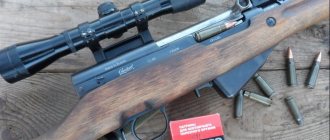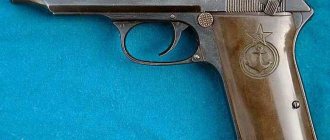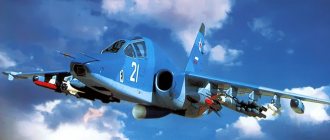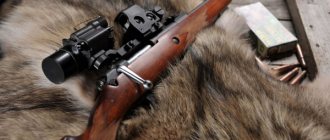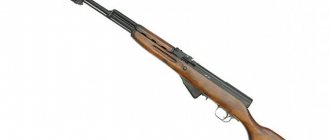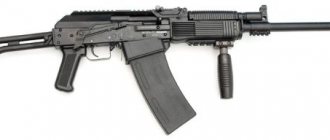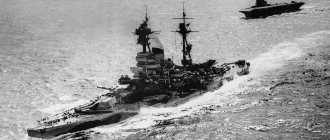A little history
The Simonov carbine is an extremely successful development of the Soviet designer Sergei Simonov. The weapon was created specifically for the 7.62 mm intermediate cartridge.
The Simonov carbine was created in 1944, and the designer took as a basis his own development of a carbine, previously created specifically for this cartridge. The carbine model, modified and ready for use, left the factories only in 1949.
Until about 1960, the weapon was supplied to the army. At that time, the SKS was the main weapon of the army, along with the Kalashnikov assault rifle and the Degtyarev machine gun. For reference: all these guns are designed specifically for the intermediate cartridge. The SKS, AK and Degtyarev machine gun complemented each other perfectly, covering the shortcomings. Thus, the AK provided a high density of fire, the SKS - the range.
The rifle was in service in many countries around the world
Around the end of the 50s of the last century, the Simonov carbine in the army began to be replaced everywhere with AKs, but the SKS lasted until the end of the 80s as the main weapon of the air defense forces.
Today this weapon is known as the Simonov SKS-45 carbine. During the heyday of this rifle, copies were produced all over the world, the rifle was mass produced by Chinese and Yugoslav arms factories. A total of 15 million samples of the Simonov carbine were produced.
Since the late 80s, the rifle gradually left the army and was transferred to the national economy. SKS-45 was used in forestry; it was used to arm rangers.
Since the 90s, the rifle has not been considered as a military weapon, but has become widespread among hunters. This became the reason for a slight modification of the SKS-45, the purpose of which was the need for differences between military and civilian Simonov self-loading carbines.
Today, the SKS-45 can still be found in the hands of amateur hunters. The “civilian” version of the rifle is distinguished by the absence of a bayonet lug, the presence of a pin in the barrel and a sighting rib reduced to 300 mm.
Many hobbyists are trying to purchase the “uncut” version of the SKS-45, which is distinguished by the presence of a bayonet mount. The use of such a carbine falls under the law “On Weapons”; an SKS-45 with a bayonet mount can be confiscated and sent to the appropriate authorities for installation of a pin and dismantling of the bayonet mount.
Today, the Simonov self-loading carbine or SKS-45 is used by hunters. Created specifically for the M43 cartridge, the carbine imposes a number of restrictions on the choice of game. Thus, they will not be able to shoot small game, and hunting large game is associated with a number of inconveniences, for example, there is a high probability of being wounded. Today, experts prefer the SKS-45 when hunting wolves, foxes, and small deer, but not game.
Characteristics of the Simonov Self-Loading Carbine (SKS)
| A country: | USSR |
| Type: | Self-loading carbine |
| Date of issue: | 1949 |
| Caliber: | 7.62 mm |
| Length: | with bayonet in combat position: 1260 mm, in stowed position: 1020 mm, barrel length: 520 mm |
| Weight: | 3.9 kg (curb) |
| Rate of fire: | up to 40 rounds per minute |
| Initial bullet speed: | 735 m/s, effective range: 400 m, bullet flight: 3.6 km |
| Ammunition: | 10 rounds 7.62×39 mm |
“Simonov self-loading carbine - capabilities, history of creation, design features and modifications”
Features of SCS
The carbine clip has ten rounds.
It is not advisable to consider the Simonov carbine or SKS-45 on a par with modern hunting weapons. It is enough to disassemble the carbine to understand how outdated it is. The fact is that all parts are made by hand on a milling machine. From the point of view of manual labor and the precision of milling work, the SKS-45 really deserves respect, but this manufacturing technology largely explains why in military affairs preference was still given to the AK, which is an order of magnitude more technologically advanced.
Externally, Simonov's carbine is very recognizable. Despite the fact that the weapon was developed for arming the army, it has a truly “hunting” grip, fits comfortably in the hand and allows you to take good aim from a standing position. At the same time, the scope is not suitable for offhand shooting, so a good grip and comfortable position in the hand are of utmost importance for this carbine, because it takes a long time to aim.
Despite its rather clumsy appearance, Simonov's carbine is very recognizable. It can often be found in various computer games, films, and videos.
Weapons such as the Simonov carbine or SKS originally used military-grade cartridges with high breaking force. From the point of view of hunting ethics, such cartridges are of little use for hunting.
Design and technical characteristics
The rifle hits a target at a distance of up to 1.5 kilometers.
The Simonov carbine is a semi-automatic rifle with a short barrel that works on the principle of removing powder gases. Gases exit through a tube located under the barrel; this principle is also implemented in the AK.
The bolt is located in the bolt frame and is connected to it by protrusions. During a shot, gases penetrate into the chamber through special holes, the piston is thrown back, hitting the front part of the bolt frame and also throwing it back. At this time, the shutter section rises, it is unlocked, the cartridge case is removed and the hammer is cocked.
The SKS magazine is integral. It is equipped with a clip of 10 rounds, or one round each. To quickly remove cartridges from the magazine, a special mechanism is provided (a latch in the rear of the magazine). By pressing the latch, the magazine lowers and opens, and the cartridges fall into the extended hand.
Disassembly and assembly of SCS
Incomplete disassembly
To lubricate and perform maintenance on the mechanism of the Simonov carbine, it is necessary to partially or completely disassemble it.
For partial disassembly you must:
- make sure that the carabiner is completely unloaded;
- remove the pencil case from the butt, prepare the necessary tools and rags;
- remove the cleaning rod;
- remove the receiver cover;
- disconnect the return mechanism, shutter;
- disconnect the stem from the bolt frame;
- remove the gas tube and receiver lining;
- remove the gas piston.
To assemble the carbine, all previous steps must be performed in reverse order, with mandatory control and inspection of parts.
Complete disassembly
It is performed if the carbine is heavily soiled, gets caught in heavy rain, fog, or falls into water. Then a complete replacement is necessary, a change in the type of oil is required, parts or mechanisms need to be repaired or replaced.
Details of the SKS-45 carbine: 1 — front sight slide; 2 — front sight; 3 — barrel with receiver (a — reflector; b — combat stop); 4 - gas tube; 5 — rod with piston; 6 — return spring contactor; 7 - guide rod; 8 — pusher; 9 — return spring; 10 - shutter; 11 — bolt frame; 12 — ejector; 13 — hairpin; 14 - drummer; 15 — guide tube; 16 — receiver cover; 17 — pusher spring; 18 — receiver cover pin; 19 — safety bracket latch; 20 — bolt stop with a spring; 21 — box; 22 — safety bracket; 23 — mainspring; 24 - fuse; 25 — fuse spring; 26 — trigger; 27 — trigger lever; 28 — guide rod; 29 — trigger; 30 - store; 31 — magazine cover latch; 32 - sear; 33 - disconnector; 34 - self-timer
The algorithm is like this:
- carry out partial disassembly of the weapon;
- remove the pusher together with the mechanism and springs;
- dismantle the trigger, disassemble it using the case body;
- remove the mainspring;
- disconnect the magazine;
- the story of dismantling the barrel, receiver;
- remove the return mechanism;
- disconnect the firing pin, ejector, bolt.
When all repair work and replacement of parts are completed, assembly is carried out in the reverse order. Work must be carried out carefully and in compliance with safety regulations. Avoid impacts and damage to parts and mechanisms when assembling/disassembling the carbine.
Tuning
Thanks to the available ability to install additional equipment, the owner of the carbine can improve the model to some extent. And many owners note the ease of tuning.
The simplest tuning can be called installing a different optical sight. Its use guarantees more effective shots and greater pleasure from the process of using the rifle.
The price for the OP SKS used hunting carbine is given below along with reviews from hunter owners.
Where was it used?
The SKS was in service in the USSR for about ten years and, accordingly, remained in the arsenals of all countries in the post-Soviet space.
But its advantages were also accepted and adopted by the armies of many other countries. These include Angola, Algeria, Guyana, Cambodia, China, North Korea, Romania, Oman, Laos, Liberia, Madagascar, Sudan, Sri Lanka and many others - about 40 states in total.
Albania established its own production in 1962. The carbine was also produced under license in the GDR under the name Karabiner-S. And in Yugoslavia, a licensed copy, called “Zastava M59,” became widespread.
He has not been forgotten by the military in the post-Soviet space either. For example, in Russia the SKS is in service with the Presidential and 154 separate commandant regiments. In Ukraine, employees of the state security service and the Navy are armed with them. In Kazakhstan, the SKS has been adopted by paramilitary security forces.
It will be difficult to talk about all the conflicts where SKS took part. The most famous are the wars in Vietnam, Afghanistan and Korea. Carbines are still used today in the conflict in eastern Ukraine.
Ammo
Shooting from the SKS is carried out with cartridges of the 1943 model (7.62×39 mm) with the following types of bullets:
- an ordinary one with a steel core is designed to defeat enemy personnel located openly or behind obstacles pierced by a bullet. The shell is steel clad with tombac, the core is steel, and there is a lead jacket between the shell and the core. Has no distinctive coloring.
- The tracer is designed for target designation and fire adjustment at distances of up to 800 m, as well as defeating enemy personnel. The core consists of an alloy of lead and antimony, behind which there is a cup with a pressed tracer compound. The color of the head part is green.
- armor-piercing incendiary is designed to ignite flammable liquids and destroy manpower located behind lightly armored shelters at ranges of up to 300 m. The shell is with a tombak tip, the core is steel with a lead jacket. Behind the core in a lead pan there is an incendiary composition. The color of the head part is black with a red belt.
- the incendiary is designed to ignite flammable liquids in iron tanks up to 3 mm thick, flammable materials at ranges up to 700 m and target designation at distances up to 700 m. The incendiary composition is located between the shell (with a tombak tip) and the steel core, the jacket is steel. Behind the core and jacket there is a cup with a tracer compound. The color of the head part is red.
Design
The simplicity of the design determines the maximum ease of use of the model. Many people note the convenience of this product in the presence of a bolt slide, the use of which speeds up the process of replacing the used clip of the OP SKS used carbine.
In general, the design of the carbine in question is as follows:
- OP SKS buttstock, made of natural material (wood) with special processing, which increases its service life;
- sighting devices - front sight and sight;
- the sight also has the following structural parts: sight block, leaf spring, sighting bar, clamp and latches for it.
The use of the carbine is determined by the specifics of its design, and since this model uses classical methods of controlling all mechanisms, operation, as an analysis of the owners’ opinions shows, should be considered quite convenient and simple.
The use of the OP SKS b/o carbine is shown in this video:
Obtaining a weapons permit
Since the SKS is a rifled weapon (except for modifications like Lancaster and VPO-208), Russian citizens can purchase it only if they have five years of experience in owning smooth-bore weapons.
To do this, you need to go to the OLRR at your place of residence to write an application for permission to purchase rifled weapons. The maximum processing time is 2 weeks. Once the permit is issued, the gun enthusiast has only a month to obtain a license to purchase. And for this you will need to collect:
- Medical certificates No. 002-O/u (issued at the hospital after examination by the relevant doctors) and No. 003-O/u (can be taken from a narcologist after passing tests).
- Passport.
- Certificate of completion of a firearms safety course.
- Receipt for payment of state duty.
The package of documents is reviewed up to 30 days. Most likely, during this time the district police officer will check whether the applicant has a safe and whether it meets the requirements.
Having received the long-awaited permit, the hunter can buy weapons. This can be done either from a private individual (there are quite a lot of advertisements on thematic forums) or in a specialized store. Six months are given for this. If this time is not enough to buy a weapon, you will need to surrender the permit and collect all the certificates again in order to get a new one.
When purchasing a rifle, the permit is neatly divided into three elements - there are special dotted lines on it. The seller retains the license, but the license is handed over to the OLRR and the buyer retains duplicates. When purchasing, a control shooting is required, on the basis of which a protocol is drawn up.
When leaving the store (or from the OLRR, if the weapon was purchased second-hand), the new owner, in addition to the weapon, must also have a test shooting protocol and a technical passport for the weapon.
After this, you need to go to the OLRR again to register the weapon and obtain a permit to store and carry it. The maximum period is 2 weeks. It is better not to delay this - even a daily delay may well result in an article, in the best case, of the administrative code.
To complete the entire procedure without unnecessary delays, you will need:
- Passport.
- Two photographs measuring 3x4 centimeters.
- Duplicate with store mark.
- A copy of the technical passport.
When you come to the OLRR, you must write a corresponding application.
Once permission is received, you can forget about the need for additional paperwork for five years. After this period, the permit will have to be renewed for another period of the same period.
Owner reviews
- Many buyers initially note the attractive design of the OP SKS b/o 7.62x39 carbine: stylish, classic and without unnecessary details.
- The price also attracts buyers - in comparison with similar models from third-party manufacturers, it can be considered one of the lowest today.
- And the technical capabilities provided by the manufacturer make it possible to evaluate the power of the shot and the effectiveness of using the weapon for a variety of purposes.
- At the same time, operational safety and reliable design guarantee the process of using the carbine without fear of damage.
- The model in question is perfect for beginners: its small and compact size, resulting in low weight, lack of recoil when shooting and good striking abilities will help develop accuracy when shooting at targets.
From military weapons to hunting weapons
When the SKS was removed from service, a completely logical question arose: what to do with the remnants? After all, about 15 million of these carbines were produced. The answer to the question was found: SKS began to be sold to hunters who have a license to purchase rifled weapons.
True, before this the weapon underwent some modification. This is how the SKS hunting carbine appeared. For example, the bayonet was removed along with the mounting bracket. In addition, the aiming bar has been significantly shortened - now it allows targeted fire at a distance of no more than 300 meters.
Fortunately, the revision was completed. After this, the weapon began to fully meet the requirements for civilian use. Reliability and ease of use have not suffered at all.
It is important that one of the main disadvantages turned out to be unimportant for hunters - the difficulty of reloading. 10 rounds in the magazine is enough to hit any prey. And you usually have to reload a weapon without haste, without your hands trembling from the heat of battle. Therefore, the SKS hunting carbine has gained considerable popularity among hunters.

